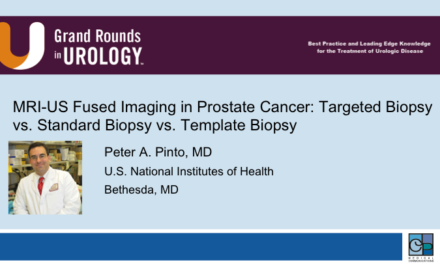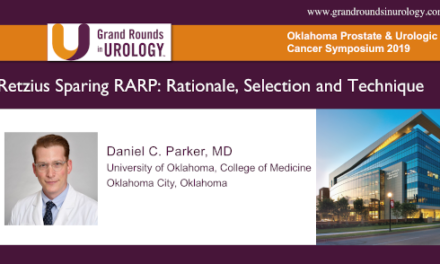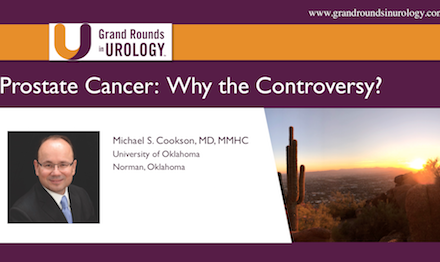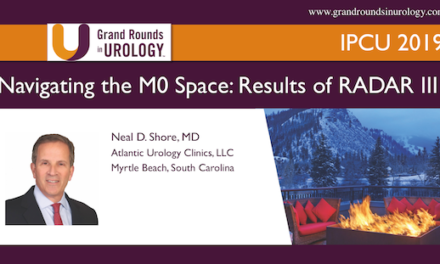Dr. Brian J. Moran spoke at the 24th International Prostate Cancer Update on Friday, February 21, 2014 on “Why There Is A Need For Focal Therapy Treatment.” In his presentation, Dr. Moran discusses the advantages of focal therapy, the importance of proper patient selection, and trying to find an optimal modality.
Presentation:
Keywords: focal therapy, prostate, biopsy, brachytherapy, PSA, MRI, modality
How to cite: Moran, Brian J. “Why There Is A Need For Focal Therapy Treatment” Grand Rounds in Urology. January 13, 2015. Accessed Dec 2024. https://dev.grandroundsinurology.com/prostate-cancer-brian-j-moran-focal-therapy-treatment/
Transcript
Why There Is A Need For Focal Therapy Treatment
That is our Chicago Prostate Center. That is the bean in downtown and Chicago has had a very hard winter. Things all frosted, now. But, I think, and this is part of my philosophy, I think prostate cancer now is being looked at as more of a spectrum disease. Where having all these advanced diagnostics, what Peter just showed us, what he talked about yesterday with all the different multi-parametric MRI data that is emerging. So, clearly, you have isolated disease, organ-confined and obviously, metastatic disease. But this spectrum, I think that many of us are referring to, would also have a morbidity spectrum or a patient spectrum, as far as age, co-morbidities, quality of life. Urodynamics in my world are very important. I do a lot of brachytherapy.
So those are things to consider and if you look at how to apply treatment to the prostate cancer spectrum, and I keep emphasizing that, you can see that it might not be an orderly progression of treatment and, thus, one size does not fit all and we have to keep this in mind. This is where I think this concept of focal therapy emerged. It really emerged from the patients.
You know, we are dealing now with the baby boomers and if you look at these statistics, I won’t go through them all, but the baby boomers are going to have a huge impact on the way we manage prostate cancer in the next couple of years. I know some of the talks later, even tonight’s talk about prostate cancer and ACOs. The economics of it, the practicality of how we apply our treatments is going to really direct where we are going.
This is the business world talking and we can write in our journals and everything, but these are the people making the decisions in Washington and these are the people that are going to be paying for it with the insurance companies, and this is real. It might be with the reduced screening we may even see a higher influx of more advanced disease. These are the baby boomers. A lot of the young people probably do not even know who they are, but certainly, I think a few of us do; Wally and the Beaver. And when they get diagnosed with prostate cancer, they are reading articles in the paper like this and they are asking themselves and they are asking themselves, “Well, jeez, you know, how much treatment do I really need?” And this is a classic patient: 60 years old, PSA 9, significant disease. I do not think anybody would say, “Just go away,” but he wants focal therapy and it is coming from the patient population. So, just conceptually, focal therapy, you have a cancer. Let’s say from a mapping biopsy we know it is in the left part of the posterior gland and rather than treat the whole prostate, the concept of focal therapy is just treat the lesion. If you just treat the lesion, how do we get the information that our treating just for the disease is? So, that is what we are going to talk about: Why do it? Theoretically, it makes sense. I think that low volume, low disease.
Is it a compromise between active surveillance versus therapy? Definitely, I think.
Primary goal: Obviously the studies that I am going to show you. This is what we have to accomplish: Lower cost, it will have implications, and then, options for failure.
Patients are asking for it. If you look at the focal therapist today, he runs a fine risk. This is a friend of mine Marco Van Vulpen from Utrecht. In Europe, focal therapy is taking off, as I will show you. But, there is a fine line between undertreatment and overtreatment. The various societies worldwide have really not embraced focal therapy, but I think that you are going to be hearing more and more about it, regardless of what side of the fence you are on.
There is a precedent. If you look at breast cancer: This is circa 1990, mastectomy for early stage disease. We have evolved with all the breast studies, the NSABP and lumpectomy with whole breast radiation and now, we are doing partial breast radiation, just to where the tumor was. So, we’re taking it one level further in the breast surgery world. There is a lot of ongoing discussion. We are already having the seventh focal therapy meeting. Various modalities have been presented at those conferences. It is very interesting to see which one of these is going to be the superhero. But, we will see.
Who are candidates? Ideally, low risk, low volume disease. You could argue intermediate-risk patients with low volume disease and you could argue high-risk patients with low volume disease. It really comes down to the information at biopsy and most of the people working with focal therapy would say that transrectal biopsy is not the right biopsy to proceed with a focal treatment. I think many of us agree it underestimates the disease.
Every meeting I go to there is just more and more talk about MRI and mapping biopsies and template-guided biopsies and yesterday there was a discussion on that by Peter, as well. So, I was in London, with Stephen Langley, and I woke up the next morning and Mark Emberton had a nice article written about him. So, in the UK, they are really pushing MRI-guided biopsies. Just about everybody is getting on the bandwagon. There is a lot at this meeting about it.
So, I do not think MRI is going to go away when it comes to the diagnosis of prostate cancer.
Mapping biopsy: This is very quickly our experience; we kind of stumbled upon it. We had patients who had rising PSAs, negative transrectal biopsies and they were really a problem for the urologists, diagnostic dilemmas.
So, we started doing template-guided mapping biopsies and before you knew it, we have a large database that Michelle, who is with me this week, has managed. And, what we have done is we have divided the prostate into eight octants. I will show you briefly, but, in summary, in 40 percent of those patients with previously negative transrectal biopsies, we find cancer, more commonly, in the apex, more commonly in the anterior apex. The way we do it is we just map the prostate. Many of you have seen these slides, but I show them because it leads into focal therapy. These patients were all done without MRI. Technique: Find the marker on the coordinates and I simplified the results. Basically, this is what we found: 35 percent of patients had one octant only, 80 percent four or less, 75 and the majority of them were Gleason 6. Does this mean 80 percent can have focal or hemi therapy? Will the results be as good? What will the potential toxicity be? These are unanswered questions that we are kind of coming up with.
What is the optimal assessment? This is the big debate on how do you judge success with focal therapy? Because you are leaving much of the gland untreated and that is going to produce PSA. So, the nadir is not as important as the PSA kinetics in what happens to the PSA kinetics after focal therapy, regardless of the modality. Now, there are some concepts but Paul McGind has suggested that a PSA velocity might be something we should look at. But, it’s not the Phoenix definition that we use with brachytherapy, or external beam.
Now, these are the ongoing studies for focal therapy and you can see that HIFU is really leading the way, much of that is being done in Europe, cryotherapy in the US and brachytherapy. Only two of these studies are low dose rate.
The remaining 13 are high dose rate studies, and then, obviously, SPRT, which is a form of external beam radiation. So, all of these are really ongoing. We do not really even have preliminary results. I think this is one of the more well-done studies. I am just going to spend a minute on Stephen Langley in London who has what they call the HAPpy study, which is Hemi-Ablative Prostate Brachytherapy.
I do not think you can do focal therapy, at this point in time, on less than half the gland, whether it is anterior or posterior, right side or left, unless you just have a very large prostate to work with. The goal, obviously, is to determine if focal brachytherapy is associated with similar local disease control, as whole gland for low- and intermediate-risk prostate cancer.
Secondary objectives, and this is something that I wrestle with, most of the studies include a posttreatment biopsy at two years and also using MRI to predict the presence of recurrent prostate cancer. I do not know if that is going to fly. It is all going to be economics. How much money are they willing to reimburse on some of these studies, at least in the US.
Patient eligibility is fairly straightforward. You can see here that the larger prostates, prostates that are not suitable for brachytherapy are probably ideal for focal therapy. The reason for that is you can get away with less toxicity if you really know where the disease is. So, a lot of the patients we are seeing for focal therapy can have even larger glands than 50 cubic centimeters.
Just finishing up on this, we used to say, “If focal therapy’s ever looked at.” But, it is not “if” anymore. It clearly is “when” focal therapy is accepted. How, where will its place be on that spectrum I described? The debate, probably within the next two to three years; we are going to have enough data to start looking at PSA responses from the various modalities and we are going to have to figure out what the role of a postimplant biopsy is. And then, obviously, salvage techniques.
Most of the surgeons I have talked to, I am not familiar with any data that is out there on salvage prostatectomy for focal therapy, but I imagine it could be done and I would leave that question to maybe Jim Eastham or some of the surgeons here that are familiar with it.
So, in conclusion, I think focal therapy definitely is here to stay. I think it has promise. I think that proper patient selection is imperative. Ideally, patients should be treated on study and the optimal modality, clearly, is yet to be determined, and salvage treatments should be considered before any focal therapy is contemplated and this is very good.
The current opinion in Urologic Oncology,–reading– “Although none of the advances in cancer detection, targeted imaging, or focal treatment have yet proven to be game changing, together, they have contributed to a movement towards less invasive, focal treatment for prostate cancer and a growing awareness of the potential clinical benefits of this form of therapy.” That is coming from some pretty strong surgeons.
So, with that I think I’ll wrap it up and it remains to be seen which modality will be the superhero of focal therapy. I want to think everybody, Tom, Dave.
Why don’t we do another ARS question just to see? This is one I’m going to find an interest:
“Is MRI imaging an absolute pre-requisite for focal therapy?”
There is a study that I did not present because it is not published, but I saw it presented in London, where they are using MR and ultrasound fusion with the planning systems and they did show about a 30 percent inaccuracy where MRI would show normal parenchyma, but they found disease.
Thank you very much.
References
Moradi M, Salcudean SE, Chang SD, et al. Multiparametric MRI maps for detection and grading of dominant prostate tumors. J Magn Reson Imaging. 2012 Jun;35(6):1403-13. http://www.ncbi.nlm.nih.gov/pubmed/22267089
ABOUT THE AUTHOR
Brian J. Moran, MD, is Medical Director of Chicago Prostate Cancer Center, which he helped found in 1997. He is also the Director of Radiation Oncology at DuPage Medical Group. He has been performing prostate seed implants since 1994. Dr. Moran is a graduate of Loyola Stritch School of Medicine, where he also completed his residency. He is board-certified by the American Board of Radiology. An experienced practitioner of prostate brachytherapy, Dr. Moran has performed thousands of prostate seed implants and has proctored physicians all over the United States and the world, including in Korea, Europe, and Hong Kong. Dr. Moran is a member of multiple specialty societies, including the American Society of Therapeutic Radiology and Oncology, the American College of Radiology, and the American Brachytherapy Society. His emphasis is on quality of life issues and long-term outcomes for prostate cancer patients. Dr. Moran is a frequent speaker at professional meetings, and has authored numerous publications in medical journals and textbooks.





